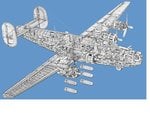- Thread starter
- #801
syscom3 said:One Factory of B24's built more Lancs total. Enough said.
There is lots of supporting facts that a B24 was built in one hour.
No they do not prove that the B-24 was easier to build, nor do they prove that they only took one hour to build. One was coming off the assy. line every hour, not being built in an hour. Trust me it takes longer than an hour to install the damn landing gear on the thing.
Take it from someone who works on aircraft. It takes longer to inspect an aircraft than you actually think it takes to build them. It took about 30 day s to build a B-24, but one was rolling off the assy line every hour.
If you think you can build a B-24 in 60 minutes then you really dont know anything about aircraft and how they are put together.



